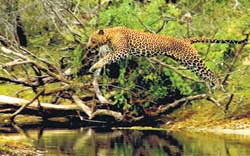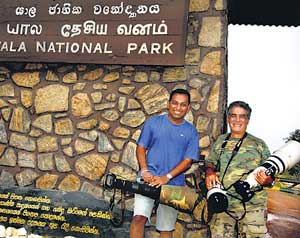
Oh! to sight a leopardA hundred and forty kilometres away from the city, I was somewhere in the Habarana wilderness last week when my phone rang. It was a call from Yala, from a dear friend, guide Prabash reporting the exciting news of two new cubs spotted at Suduwelimulla in Yala. Coincidentally, it was Prabash who had made the first spotting of the new cubs at Padi Kema around this time last year. Sightings of the two new cubs at Suduwelimulla were regular, Prabash said. This will, no doubt, be music to the ears of many leopard lovers planning their mid-year visits to the park, with normalcy soon returning to Yala. Visitor-confidence has returned and with park authorities and the security personnel giving assurances, tourists and wildlife lovers have begun to trickle in to Yala again. The long weekends have brought a number of visitors back to their favourite park and they have not been disappointed. Leopard sightings have been on a steady rise since early this year with the naturalists at Yala Village once again keeping tabs on the number of sightings made by park visitors.
Yala, traditionally home to a high density of elephants and tuskers has gradually begun to attract attention for the leopard. In the latter part of 1999, watching leopard cubs had a shot in the arm at Yala with the emergence of the “Heenwewa” cubs. Photographers were thrilled as the growing cubs came out to the open glades of Heenwewa and posed for the long lenses. Then came the “Meda para” cubs and later the “Kotabendi wewa” cubs in 2003. By this time, “Leopard Hunters”, a painstakingly crafted movie about the leopards of Yala was already winning accolades the world over. Yala was soon identified as a hot destination to observe the leopard. Before long, visitors to the park wouldn’t bother stopping for elephants as sighting a leopard would be the top attraction of Yala. I had been among the early converts pursuing the beauty and the elusive nature of this top cat, and soon invested in the ideal optical equipment that would give me an edge over this crafty predator. There was a group of young photographers who dedicated much of their time to recording the sightings at Yala that culminated in the first publication dedicated to the animal in Sri Lanka –“For the Leopard”. I began my own endeavour of publishing my photographs jointly with Dr. Ravi Samarasinha whose passionate research answered many of the questions we had in identifying these cats of Yala. An opportunity to work at Nature Odyssey and Yala Village was naturally too tempting to miss, and I found myself heading a small team of naturalists who would enthusiastically track and record leopard sightings. As we began to intimately understand the distribution of leopards within the park, we thought of taking this to the world through leopard safaris. It was early 2007, when I was introduced to world renowned wildlife photographer Amos Nachoum of Big Animals fame in USA. It took me five months to convince him that Yala was the top destination to observe leopards in Asia and perhaps in the world. Invitation accepted, the challenge was now ours to make this photo recce count, and make an impression on this most celebrated photographer. Amos would spend 12 nights in the island photographing the great gathering of elephants at Minneriya based at the Cinnamon Lodge, and we would travel cross country through Mahiyangana, Bibile and arrive at Yala National Park for the highlight of the adventure, Leopards of Sri Lanka. Six days spent at Yala gave us 22 sightings including leopards at water, making a kill, sitting on lofty hideouts and just out in the open plains of Buttuwa. I remember on the fourth day, twelve hours in the park and ten sightings in the bag, even Amos was humbled. Back at the Yala Village, a cool beer at the observation deck overlooking the ocean under the stars – Amos accepted that Yala indeed was the best location to observe the leopard.
An outstandingly successful mission, concluded almost to the script, we arrived back in Colombo and Amos flew back looking forward to more visits here. My work at the Yala Village and my other stations continued with regular visits to the park while we dreamt of encountering the new cubs at Padi Kema before the end of the season in 2007. Late September, on a shoot with a friend, a sudden mobile alert broke news of the cubs observed at the Padi Kema rock during midday. I scrambled to my cab with the 800mm and drove to the park office and scrambled my guide to reach the spot to no avail. The midday heat had made the cubs scamper for shelter. But after hours of patient waiting, at a quarter past five, they appeared on the main rock. It was an awe-inspiring sight to stay put in one location for three and a half hours and catch this family at their evening outing. With the onset of the drought, sightings could improve in only one direction, upwards. Let’s hope that this irreplaceable cluster of bio-diversity heaped in a melody of diverse habitats that makes up the Yala sanctuaries will be preserved for posterity and that leopard lovers will once again visit this most heavenly destination to catch a glimpse of this predator of the night walk the jungles of Yala by day. |
|
||||||
|| Front
Page | News | Editorial | Columns | Sports | Plus | Financial
Times | International | Mirror | TV
Times | Funday
Times || |
| |
Reproduction of articles permitted when used without any alterations to contents and a link to the source page.
|
© Copyright
2008 | Wijeya
Newspapers Ltd.Colombo. Sri Lanka. All Rights Reserved. |

